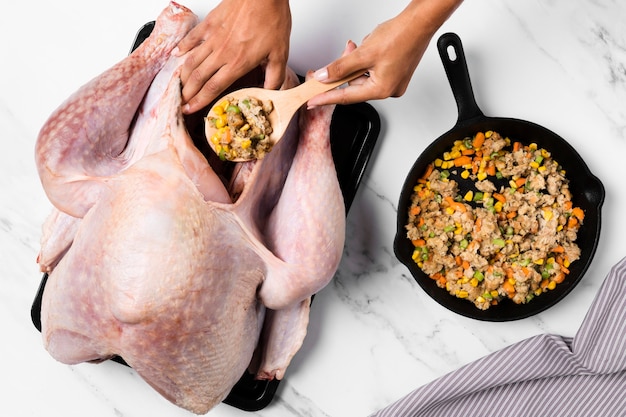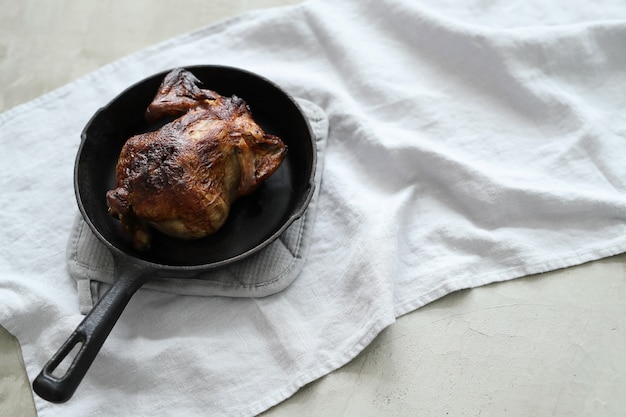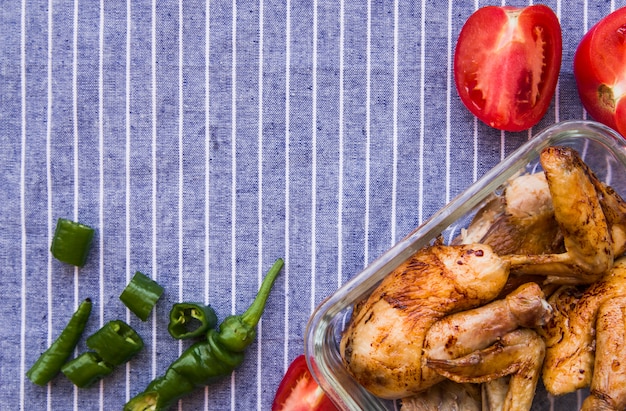Let’s talk chicken drumsticks! There’s nothing quite like that crispy skin, juicy meat, and perfectly cooked chicken. But then, the dreaded question arises: What temperature is best for these delectable little nuggets?
I've been in the kitchen for years, and I've learned a thing or two about chicken drumsticks. I've had my fair share of dry, overcooked disasters and, honestly, a few raw ones too (let's not dwell on those). But through trial and error, I've finally cracked the code to achieving that perfect, juicy chicken drumstick every single time.
This isn’t just a simple guide; it’s a culinary adventure. I’m taking you on a journey, sharing my experiences, tips, and tricks that I've picked up over the years. We'll explore the different methods of cooking chicken drumsticks, delve into the science behind achieving that perfect temperature, and even uncover how to tell if your chicken is done without solely relying on a thermometer. So, grab a cuppa, get comfy, and let's embark on this flavorful journey together!
(Part 1) Understanding the Science of Chicken Perfection

The Significance of internal temperature: A Safety First Approach
It all boils down to temperature, my friends. When it comes to chicken, you've got to get that internal temperature spot on. Chicken is a delicate creature; it can go from tender and juicy to dry and tough in the blink of an eye.
Let’s talk about the magic number: 165°F (74°C). This is the minimum safe internal temperature that eliminates any harmful bacteria lurking in your chicken. But hold on a second! Reaching that temperature doesn’t automatically guarantee a perfectly cooked chicken drumstick. It’s about the entire cooking process, not just the final destination.
The Danger Zone: A Culinary No-Man's Land
The "danger zone," as it's called, is that crucial temperature range between 40°F (4°C) and 140°F (60°C). This is where bacteria can multiply rapidly. You've got to avoid keeping your chicken in this zone for too long, whether it's during preparation or while it’s cooking.
The Secret to Juicy Chicken: Mastering the Art of Resting
When you cook chicken, the proteins within the meat start to tighten up. The longer you cook it, the more they tighten, leading to drier meat. That's why reaching the safe temperature is crucial, but it's not the complete story.
The key is to cook the chicken to the perfect temperature and then let it rest. This allows the proteins to relax, making the chicken more tender and juicy. It's like giving the chicken a little breather after a workout!
(Part 2) Exploring Different Cooking Methods and Temperature Considerations

Oven Baking: A Classic and Reliable Method
I’ll be honest; oven baking is my go-to for chicken drumsticks. It’s simple, fuss-free, and it yields a lovely crispy skin. For oven baking, I recommend a temperature between 350°F (175°C) and 400°F (200°C).
Here's a little trick I learned from my granny: Preheat your oven to 400°F (200°C) for those first 15 minutes to get that skin nice and crispy. Then, reduce the temperature to 350°F (175°C) and let the chicken cook through. This prevents the skin from burning while ensuring the meat cooks evenly.
Oven baking tips: Elevating Your Chicken Game
- Don’t overcrowd the pan! Give your chicken drumsticks some space to breathe. This allows for even cooking and prevents steam buildup, which can make the skin soggy.
- Add a little water to the bottom of the pan. This creates steam, which helps to keep the chicken moist. Just be sure to check the water level halfway through cooking and add more if needed.
- Don't be afraid to flip those drumsticks! Flipping them halfway through cooking ensures they brown evenly on all sides.
Grilling: A Smoky and Charred Delight
For a smoky, charred flavor, there’s nothing like grilling your chicken drumsticks. The key is to use medium-high heat, around 400°F (200°C), and cook those beauties over indirect heat. This prevents the chicken from burning on the outside before it's cooked through.
grilling tips: Mastering the Art of Outdoor Cooking
- Don't forget to preheat your grill! This is crucial for achieving that beautiful sear on your chicken.
- Use a meat thermometer! This will ensure that your chicken reaches a safe internal temperature.
- Don't overcook! Keep an eye on your chicken and take it off the grill as soon as it reaches the desired internal temperature.
Deep Frying: A Classic Technique for Crispy Perfection
Now, let's talk deep frying. This method gives you that classic crispy outer layer and juicy inner meat. I recommend using a temperature between 350°F (175°C) and 375°F (190°C) for deep frying.
Deep Frying Tips: Ensuring Safe and Delicious Results
- Use a thermometer to check the temperature of your oil. This is crucial for achieving a crispy crust without overcooking the chicken.
- Don't overcrowd the fryer! Overcrowding the fryer will lower the temperature of the oil, resulting in soggy chicken.
- Let the chicken rest for a few minutes after frying. This allows the juices to redistribute, resulting in juicier meat.
Air Frying: A Healthier Option for crispy chicken
For those who want the crispy goodness without the fuss of deep frying, air frying is a great option. I suggest a temperature between 400°F (200°C) and 425°F (220°C).
Air Frying Tips: Maximizing Air Fryer Efficiency
- Don't overcrowd the air fryer! This will prevent the chicken from cooking evenly.
- Flip the chicken halfway through cooking. This ensures that it cooks evenly on all sides.
- Use a meat thermometer to ensure that the chicken reaches the desired internal temperature.
(Part 3) Understanding Temperature Considerations and Timing

cooking time and Temperature: A Guide for Success
Remember, cooking time and temperature are not set in stone! The size and thickness of your chicken drumsticks will play a significant role in determining how long they need to cook.
Here’s a general guide based on my experience, but always double-check with a meat thermometer:
Cooking Time Guide: A Helpful Reference Chart
| Cooking Method | Temperature (°F) | Approximate Cooking Time |
|---|---|---|
| Oven Baking | 350-400 | 25-35 minutes |
| Grilling | 400 | 20-25 minutes |
| Deep Frying | 350-375 | 10-15 minutes |
| Air Frying | 400-425 | 15-20 minutes |
The Art of Checking for Doneness: Beyond the Thermometer
So, you've got your chicken in the oven, on the grill, or in the fryer. Now, how do you know when it's done? I'm going to let you in on a little secret: I don’t always rely solely on a thermometer.
Here’s a trick I've learned over time: When the chicken is cooked through, the juices should run clear when you cut into it. Also, the meat should be firm to the touch, not jiggly.
Resting Time: A Crucial Step for Juicy Chicken
Once your chicken drumsticks reach the desired internal temperature, don’t jump right into digging in! Give them a 5-10 minute rest before serving. This allows the juices to redistribute, resulting in tender, juicy chicken.
(Part 4) Exploring Variations and flavor enhancers
Marination Magic: Infusing Flavor into Your Chicken
Adding a marinade is a fantastic way to infuse your chicken with extra flavor. I love using a simple marinade of soy sauce, honey, and garlic. It’s simple yet adds a lovely depth of flavor to the chicken.
But don’t be afraid to experiment! There are endless possibilities for marinades. You can try citrusy marinades, spicy marinades, or even herb-based marinades.
The Power of Herbs and Spices: Elevating Taste with Flavorful Touches
Herbs and spices add so much flavor to chicken drumsticks. I love using a mix of paprika, cumin, and garlic powder. But feel free to get creative!
Some other delicious options include:
- Lemon pepper
- Cajun spices
- Italian herbs
Glazes and Sauces: Taking Your Chicken to the Next Level
To take your chicken drumsticks to the next level, consider adding a glaze or sauce. A simple honey-soy glaze adds a beautiful shine and a delicious sweet and savory flavor.
You can also try:
- bbq sauce
- Buffalo sauce
- Teriyaki sauce
(Part 5) Choosing the Right Chicken: Making Informed Decisions
Organic vs. Conventional: A Matter of Choice
It’s a common question – organic or conventional? Personally, I prefer organic chicken whenever possible. It’s raised without antibiotics and hormones, which means it’s healthier for you and me. But if you're on a budget, conventional chicken is still a good option.
Chicken Parts and Cuts: Exploring Different Options
Chicken drumsticks are my absolute favorite! They're just the right size, and they cook up so beautifully. But if you’re feeling adventurous, there are other cuts of chicken you can try.
Fresh vs. Frozen: A Decision Based on Availability and Preference
I always go for fresh chicken whenever I can. It has a better flavor and texture than frozen chicken. But if you're in a pinch, frozen chicken is a good option. Just be sure to thaw it completely before cooking.
(Part 6) Storage and Leftovers: Making the Most of Your ChickenRefrigerating Leftovers: Safe Storage for Fresh Chicken
Once your chicken drumsticks have cooled down, store them in an airtight container in the refrigerator for up to 3-4 days.
Freezing Leftovers: Extending the Lifespan of Your Chicken
You can also freeze your chicken drumsticks for up to 2-3 months. Just be sure to wrap them tightly in plastic wrap and then place them in a freezer-safe bag.
Reheating Leftovers: Ensuring Safe and Delicious Results
To reheat your chicken drumsticks, you can bake them in the oven, microwave them, or pan-fry them. Just be sure to heat them through to an internal temperature of 165°F (74°C).
(Part 7) Safety Tips: Ensuring a Safe and Enjoyable Culinary Experience
Safe Handling and Cleaning: Preventing Cross-Contamination
When you’re handling raw chicken, it’s important to practice proper hygiene to prevent cross-contamination. Always wash your hands thoroughly with soap and water after handling raw chicken. Also, make sure to wash all surfaces and utensils that came into contact with raw chicken.
Meat Thermometers: A Culinary Essential for Safe Cooking
A meat thermometer is an essential tool for cooking chicken. It takes the guesswork out of knowing if your chicken is cooked through. There are different types of meat thermometers available, including digital and instant-read thermometers. Choose one that is accurate and easy to use.
Storing Raw Chicken: Maintaining food safety in the Kitchen
Always store raw chicken in the refrigerator at 40°F (4°C) or lower. Never leave raw chicken out at room temperature for more than two hours. If you're storing raw chicken in the freezer, be sure to wrap it tightly in plastic wrap or aluminum foil to prevent freezer burn.
(Part 8) FAQs: Answering Your Burning Questions
Q1: Can I cook chicken drumsticks in a slow cooker?
A: Absolutely! slow cooking is a great way to cook chicken drumsticks. Just be sure to use a low setting and cook for 4-6 hours. You can also add some liquid, like broth or water, to the slow cooker to prevent the chicken from drying out.
Q2: What’s the best way to prevent my chicken drumsticks from getting dry?
A: The key to preventing dry chicken drumsticks is to cook them to the right temperature and then let them rest. Also, adding a little bit of liquid to the pan or slow cooker can help to keep the chicken moist.
Q3: What if my chicken drumsticks are a bit undercooked?
A: If you're concerned that your chicken drumsticks may be undercooked, you can always cook them a little longer. Just be sure to check the internal temperature with a meat thermometer to ensure that it reaches a safe temperature of 165°F (74°C).
Q4: Can I cook chicken drumsticks with the skin on or off?
A: You can cook chicken drumsticks with the skin on or off, but cooking them with the skin on will give you a crispier result. If you prefer a less crispy chicken drumstick, you can remove the skin before cooking.
Q5: What are some other ways to cook chicken drumsticks?
A: You can also cook chicken drumsticks in a variety of other ways, such as roasting, poaching, or braising. Just be sure to adjust the cooking time and temperature accordingly.
There you have it, folks! My secrets to achieving the perfect juicy chicken drumsticks. Now go forth and conquer those poultry cravings. I know you’ve got this!
Everyone is watching

Prime Rib Roast Cooking Time Chart: Per Pound Guide
Cooking TipsPrime rib roast. Just the name conjures images of lavish dinners, crackling fires, and hearty laughter. It’s ...

How Long to Bake Potatoes in the Oven (Perfect Every Time)
Cooking TipsBaked potatoes are a staple in my kitchen. They're incredibly versatile, delicious, and surprisingly easy to m...

Perfect Rice Every Time: The Ultimate Guide to Cooking Rice
Cooking TipsAs a self-proclaimed foodie, I've always been a bit obsessed with rice. It's the foundation of countless cuisi...

The Ultimate Guide to Cooking Asparagus: Tips, Techniques, and Recipes
Cooking TipsAsparagus. The mere mention of this spring delicacy conjures up images of vibrant green spears, crisp and burs...

Ultimate Guide to Cooking the Perfect Thanksgiving Turkey
Cooking TipsThanksgiving. Just the word conjures up images of overflowing tables laden with delicious food, the scent of r...
